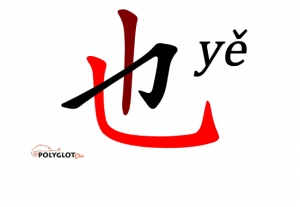Difference between revisions of "Language/Mandarin-chinese/Grammar/也-yě"
< Language | Mandarin-chinese | Grammar
Jump to navigation
Jump to search
m (Quick edit) |
|||
| (7 intermediate revisions by 3 users not shown) | |||
| Line 1: | Line 1: | ||
The adverb <code>也</code> <yě> means | [[File:也-polyglot-club-wiki.png|thumb]] | ||
The adverb <code>也</code> <yě> means “too” or “also”. | |||
<code>也</code> <yě> is placed before the verb. | Like all adverbs in Chinese, <code>也</code> <yě> is placed before the verb. | ||
With the completion of this lesson, consider investigating these related pages: [[Language/Mandarin-chinese/Grammar/%E6%98%AF...%E7%9A%84|是...的]], [[Language/Mandarin-chinese/Grammar/How-to-ask-a-question-in-Chinese|How to ask a question in Chinese]], [[Language/Mandarin-chinese/Grammar/Questions-with-不-(bù)|Questions with 不 (bù)]] & [[Language/Mandarin-chinese/Grammar/Questions|Questions]]. | |||
==structure== | ==structure== | ||
<code>Subject + | <code>Subject + Adverb + Verb + Object</code> | ||
<code>Subject + 也 + Verb + Object</code> | <code>Subject + 也 + Verb + Object</code> | ||
*<span class="notranslate">他 <code>也</code> | *<span class="notranslate">他 <code>也</code> 是 法國人。/他 <code>也</code> 是 法国人。 ‹ Tā yě shì Fǎguórén. › </span> | ||
<blockquote>He is also French.</blockquote> | <blockquote>He is also French.</blockquote> | ||
==Other Lessons== | |||
* [[Language/Mandarin-chinese/Grammar/呢-ne|呢 ne]] | |||
* [[Language/Mandarin-chinese/Grammar/Transition-words|Transition words]] | |||
* [[Language/Mandarin-chinese/Grammar/Express-existence-with-有-(yǒu)|Express existence with 有 (yǒu)]] | |||
* [[Language/Mandarin-chinese/Grammar/Separable-verbs|Separable verbs]] | |||
* [[Language/Mandarin-chinese/Grammar/Time|Time]] | |||
* [[Language/Mandarin-chinese/Grammar/不-(bù)|不 (bù)]] | |||
* [[Language/Mandarin-chinese/Grammar/了-le|了 le]] | |||
* [[Language/Mandarin-chinese/Grammar/Adjectives|Adjectives]] | |||
* [[Language/Mandarin-chinese/Grammar/Express-possession-with-有-(yǒu)|Express possession with 有 (yǒu)]] | |||
* [[Language/Mandarin-chinese/Grammar/Ask-for-directions-in-Chinese|Ask for directions in Chinese]] | |||
<span links></span> | |||
Latest revision as of 23:07, 26 March 2023
The adverb 也 <yě> means “too” or “also”.
Like all adverbs in Chinese, 也 <yě> is placed before the verb.
With the completion of this lesson, consider investigating these related pages: 是...的, How to ask a question in Chinese, Questions with 不 (bù) & Questions.
structure[edit | edit source]
Subject + Adverb + Verb + Object
Subject + 也 + Verb + Object
- 他
也是 法國人。/他也是 法国人。 ‹ Tā yě shì Fǎguórén. ›
He is also French.
Other Lessons[edit | edit source]
- 呢 ne
- Transition words
- Express existence with 有 (yǒu)
- Separable verbs
- Time
- 不 (bù)
- 了 le
- Adjectives
- Express possession with 有 (yǒu)
- Ask for directions in Chinese
